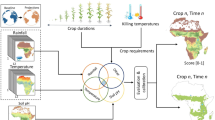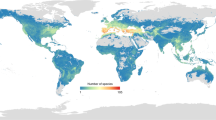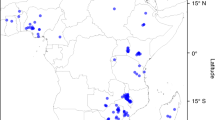Abstract
Climate change is expected to severely impact cultivated plants and consequently human livelihoods1,2,3, especially in sub-Saharan Africa (SSA)4,5,6. Increasing agricultural plant diversity (agrobiodiversity) could overcome this global challenge7,8,9 given more information on the climatic tolerance of crops and their wild relatives. Using >200,000 worldwide occurrence records for 29 major crops and 778 of their wild relative species, we assess, for each crop, how future climatic conditions are expected to change in SSA and whether populations of the same crop from other continents, wild relatives around the world or other crops from SSA are better adapted to expected future climatic conditions in the region. We show that climate conditions not currently experienced by the 29 crops in SSA are predicted to become widespread, increasing production insecurity, especially for yams. However, crops such as potato, squash and finger millet may be maintained by using wild relatives or non-African crop populations with climatic niches more suited to future conditions. Crop insecurity increases over time and with rising GHG emissions, but the potential for using agrobiodiversity for resilience is less altered. Climate change will therefore affect sub-Saharan agriculture but agrobiodiversity can provide resilient solutions in the short and medium term.
This is a preview of subscription content, access via your institution
Access options
Access Nature and 54 other Nature Portfolio journals
Get Nature+, our best-value online-access subscription
$29.99 / 30 days
cancel any time
Subscribe to this journal
Receive 12 print issues and online access
$209.00 per year
only $17.42 per issue
Buy this article
- Purchase on Springer Link
- Instant access to full article PDF
Prices may be subject to local taxes which are calculated during checkout




Similar content being viewed by others
Data availability
The data that support the findings of this study are available from several databases listed in the Methods of the manuscript. Data are available from the authors on reasonable request and following data restrictions from these databases.
Code availability
The main R functions and packages used in this study are provided in the Methods. Full R scripts are available from the authors on reasonable request.
References
Lobell, D. B., Schlenker, W. & Costa-Roberts, J. Climate trends and global crop production since 1980. Science 333, 616–620 (2011).
Wheeler, T. & von Braun, J. Climate change impacts on global food security. Science 341, 508–513 (2013).
Challinor, A. J. et al. A meta-analysis of crop yield under climate change and adaptation. Nat. Clim. Change 4, 287–291 (2014).
Morton, J. F. The impact of climate change on smallholder and subsistence agriculture. Proc. Natl Acad. Sci. USA 104, 19680–19685 (2007).
Muller, C., Cramer, W., Hare, W. L. & Lotze-Campen, H. Climate change risks for African agriculture. Proc. Natl Acad. Sci. USA 108, 4313–4315 (2011).
Kurukulasuriya, P. et al. Will African agriculture survive climate change? World Bank Econ. Rev. 20, 367–388 (2006).
Dwivedi, S., Sahrawat, K., Upadhyaya, H. & Ortiz, R. Food, nutrition and agrobiodiversity under global climate change. Adv. Agron. 120, 1–128 (2013).
Ramankutty, N. et al. Trends in global agricultural land use: implications for environmental health and food security. Annu. Rev. Plant Biol. 69, 789–815 (2018).
Waha, K. et al. Agricultural diversification as an important strategy for achieving food security in Africa. Glob. Change Biol. 24, 3390–3400 (2018).
IPCC Climate Change 2013: The Physical Science Basis (eds Stocker, T. F. et al.) (Cambridge Univ. Press, 2014).
Parmesan, C. Ecological and evolutionary responses to recent climate change. Annu. Rev. Ecol. Evol. Syst. 37, 637–669 (2006).
Tester, M. & Langridge, P. Breeding technologies to increase crop production in a changing world. Science 327, 818–822 (2010).
Zhang, H., Mittal, N., Leamy, L. J., Barazani, O. & Song, B.-H. Back into the wild—apply untapped genetic diversity of wild relatives for crop improvement. Evol. Appl. 10, 5–24 (2017).
Castañeda-Álvarez, N. P. et al. Global conservation priorities for crop wild relatives. Nat. Plants 2, 16022 (2016).
Dempewolf, H. et al. Adapting agriculture to climate change: a global initiative to collect, conserve and use crop wild relatives. Agroecol. Sustain. Food Syst. 38, 369–377 (2014).
FAOSTAT (FAO, 2019); http://faostat3.fao.org/
Adoption of the Paris Agreement FCC/CP/2015/L.9/Rev.1 (UNFCCC, 2015).
Siebert, S. et al. Development and validation of the global map of irrigation areas. Hydrol. Earth Syst. Sci. Discuss. 2, 1299–1327 (2005).
Mueller, N. D. et al. Closing yield gaps through nutrient and water management. Nature 490, 254–257 (2012).
Atwater, D. Z., Ervine, C. & Barney, J. N. Climatic niche shifts are common in introduced plants. Nat. Ecol. Evol. 2, 34–43 (2018).
Rippke, U. et al. Timescales of transformational climate change adaptation in sub-Saharan African agriculture. Nat. Clim. Change 6, 605–609 (2016).
Ortiz, R., Jarvis, A., Fox, P., Aggarwal, P. K. & Campbell, B. M. Plant Genetic Engineering, Climate Change and Food Security (CGIAR and CCAFS, 2014).
Ramírez-Villegas, J. et al. Climate Analogues: Finding Tomorrow’s Agriculture Today (CGIAR and CCAFS, 2011).
Burke, M. B., Lobell, D. B. & Guarino, L. Shifts in African crop climates by 2050, and the implications for crop improvement and genetic resources conservation. Glob. Environ. Change 19, 317–325 (2009).
Stokstad, E. The new potato. Science 363, 574–577 (2019).
Longo, R. M. J. Information transfer and the adoption of agricultural innovations. J. Am. Soc. Inf. Sci. 41, 1–9 (1990).
Borrell, J. S. et al. Enset in Ethiopia: a poorly characterized but resilient starch staple. Ann. Bot. 123, 747–766(2019).
Hoffman, A. L., Kemanian, A. R. & Forest, C. E. Analysis of climate signals in the crop yield record of sub-Saharan Africa. Glob. Change Biol. 24, 143–157 (2018).
Ray, D. K., Gerber, J. S., MacDonald, G. K. & West, P. C. Climate variation explains a third of global crop yield variability. Nat. Commun. 6, 5989 (2015).
The International Treaty on Plant Genetic Resources for Food and Agriculture (Food and Agriculture Organization, 2001).
Harlan, J. R. & de Wet, J. M. J. Toward a rational classification of cultivated plants. Taxon 20, 509 (1971).
Maxted, N., Ford-Lloyd, B. V., Jury, S., Kell, S. & Scholten, M. Towards a definition of a crop wild relative. Biodivers. Conserv. 15, 2673–2685 (2006).
Dauby, G. et al. RAINBIO: a mega-database of tropical African vascular plants distributions. PhytoKeys 2016, 1–18 (2016).
Waha, K., Zipf, B., Kurukulasuriya, P. & Hassan, R. M. An agricultural survey for more than 9,500 African households. Sci. Data 3, 160020 (2016).
Hijmans, R. J., Phillips, S., Leathwick, J. R. & Elith, J. dismo: Species distribution modeling. R package version 1.1-4 (2017).
R Core Team R: A Language and Environment for Statistical Computing (R Foundation for Statistical Computing, 2016).
Dinerstein, E. et al. An ecoregion-based approach to protecting half the terrestrial realm. BioScience 67, 534–545 (2017).
Karger, D. N. et al. Climatologies at high resolution for the earth’s land surface areas. Sci. Data 4, 170122 (2017).
Pironon, S. et al. The ‘Hutchinsonian niche’ as an assemblage of demographic niches: implications for species geographic ranges. Ecography 41, 1103–1113 (2018).
Hijmans, R. J. et al. raster: Geographic data analysis and modeling. R package version 3.0-2 (2019).
Reside, A. E., Watson, I., VanDerWal, J. & Kutt, A. S. Incorporating low-resolution historic species location data decreases performance of distribution models. Ecol. Model. 222, 3444–3448 (2011).
Guisan, A., Graham, C. H., Elith, J. & Huettmann, F. and the NCEAS Species Distribution Modelling Group Sensitivity of predictive species distribution models to change in grain size. Divers. Distrib. 13, 332–340 (2007).
Guisan, A. & Thuiller, W. Predicting species distribution: offering more than simple habitat models. Ecol. Lett. 8, 993–1009 (2005).
Pearson, R. G. & Dawson, T. P. Predicting the impacts of climate change on the distribution of species: are bioclimate envelope models useful? Glob. Ecol. Biogeogr. 12, 361–371 (2003).
Knox, J., Hess, T., Daccache, A. & Wheeler, T. Climate change impacts on crop productivity in Africa and South Asia. Environ. Res. Lett. 7, 034032 (2012).
Buisson, L., Thuiller, W., Casajus, N., Lek, S. & Grenouillet, G. Uncertainty in ensemble forecasting of species distribution. Glob. Change Biol. 16, 1145–1157 (2010).
Knutti, R., Masson, D. & Gettelman, A. Climate model genealogy: generation CMIP5 and how we got there. Geophys. Res. Lett. 40, 1194–1199 (2013).
Danielson, J. J. & Gesch, D. B. Global Multi-resolution Terrain Elevation Data 2010 (GMTED2010) (USGS, 2011).
Dray, S. & Dufour, A.-B. The ade4 Package: implementing the duality diagram for ecologists. J. Stat. Softw. 22, 1–20 (2007).
R Core Team and contributors worldwide. grDevices: The R graphics devices and support for colours and fonts. R package version 3.4.1 (2019).
Pebesma, E. et al. sp: Classes and methods for spatial data. R package version 1.3-1 (2018).
Blonder, B. Hypervolume concepts in niche- and trait-based ecology. Ecography 41, 1441–1455 (2017).
Qiao, H., Soberón, J. & Peterson, A. T. No silver bullets in correlative ecological niche modelling: insights from testing among many potential algorithms for niche estimation. Methods Ecol. Evol. 6, 1126–1136 (2015).
Merow, C. et al. What do we gain from simplicity versus complexity in species distribution models? Ecography 37, 1267–1281 (2014).
Etherington, T. R. Mahalanobis distances and ecological niche modelling: correcting a chi-squared probability error. PeerJ 7, e6678 (2019).
Giraudoux, P., Antonietti, J.-P., Beale, C., Pleydell, D. & Treglia, M. pgirmess: Spatial analysis and data mining for field ecologists. R package version 1.6.9 (2018).
Acknowledgements
We acknowledge the financial support of the UK Natural Environment Research Council (NERC) for the Belmont Forum project FICESSA (Food Security Impacts of Industrial Crop Expansion in Sub-Sahara Africa) NE/M021351/1, as well as the Norwegian Ministry of Foreign Affairs and the Global Crop Diversity Trust for the ‘Adapting Agriculture to Climate Change: Collecting, Protecting and Preparing Crop Wild Relatives’ project. Funders had no role in the preparation of this manuscript. We thank G. Dauby and T. Couvreur for providing unpublished data from the Rainbio database, N. Castañeda-Álvarez for her help with the Crop Wild Relatives Atlas, O. Romero for his help with extracting data from the Genesys database, A. Gasparatos, B. Siddighi Balde and M. Jarzebski for providing data from the agricultural surveys conducted for the FICESSA project, G. von Maltitz for helping selecting crop species and E. Hammond Hunt and M. Soto Gomez for comments on the manuscript and technical assistance.
Author information
Authors and Affiliations
Contributions
S.P., T.R.E., M.M.-F. and K.J.W. designed the study with help from all co-authors. S.P., N.K. and J.S.B. collected data. S.P. analysed the data with help from I.O. S.P. wrote the manuscript, with substantial help from all co-authors.
Corresponding author
Ethics declarations
Competing interests
The authors declare no competing interests.
Additional information
Peer review information Nature Climate Change thanks Luigi Guarino and the other, anonymous, reviewer(s) for their contribution to the peer review of this work.
Publisher’s note Springer Nature remains neutral with regard to jurisdictional claims in published maps and institutional affiliations.
Supplementary information
Supplementary Information
Supplementary Figs. 1–9 and Tables 1–6.
Rights and permissions
About this article
Cite this article
Pironon, S., Etherington, T.R., Borrell, J.S. et al. Potential adaptive strategies for 29 sub-Saharan crops under future climate change. Nat. Clim. Chang. 9, 758–763 (2019). https://doi.org/10.1038/s41558-019-0585-7
Received:
Accepted:
Published:
Issue Date:
DOI: https://doi.org/10.1038/s41558-019-0585-7
This article is cited by
-
Genome Scan of Rice Landrace Populations Collected Across Time Revealed Climate Changes’ Selective Footprints in the Genes Network Regulating Flowering Time
Rice (2023)
-
Indigenous knowledge is key to sustainable food systems
Nature (2023)
-
High-Night Temperature-Induced Changes in Chlorophyll Fluorescence, Gas Exchange, and Leaf Anatomy Determine Grain Yield in Rice Varieties
Journal of Plant Growth Regulation (2023)
-
Microplastic/nanoplastic toxicity in plants: an imminent concern
Environmental Monitoring and Assessment (2023)
-
Coupling genetic structure analysis and ecological-niche modeling in Kersting’s groundnut in West Africa
Scientific Reports (2022)



